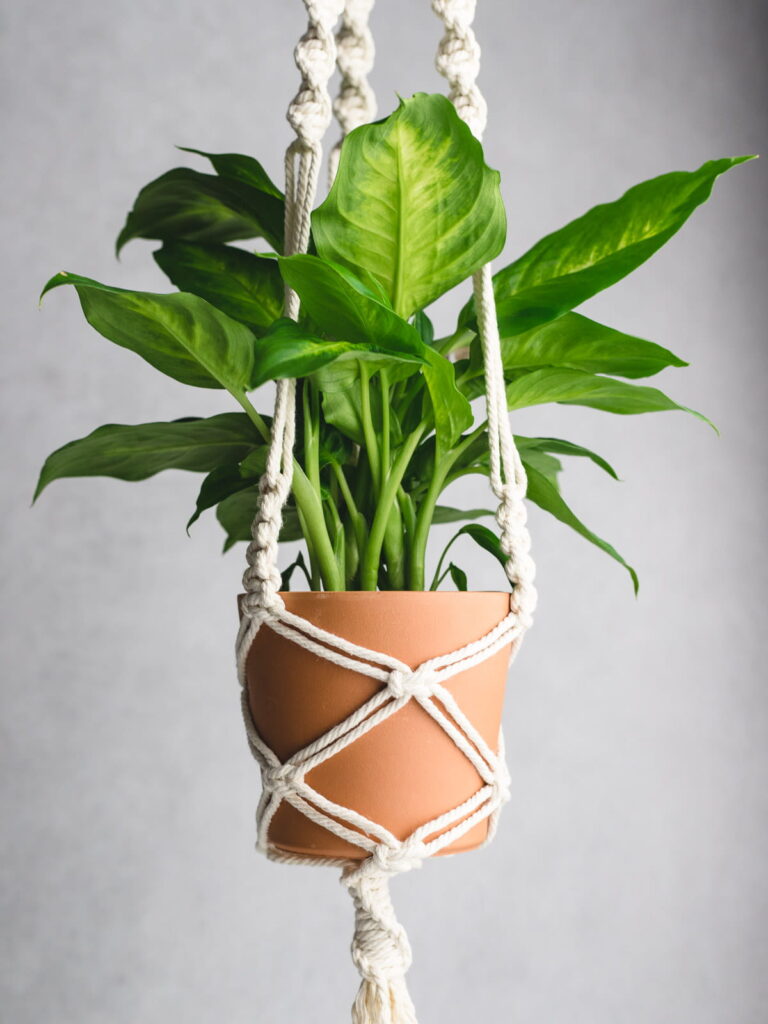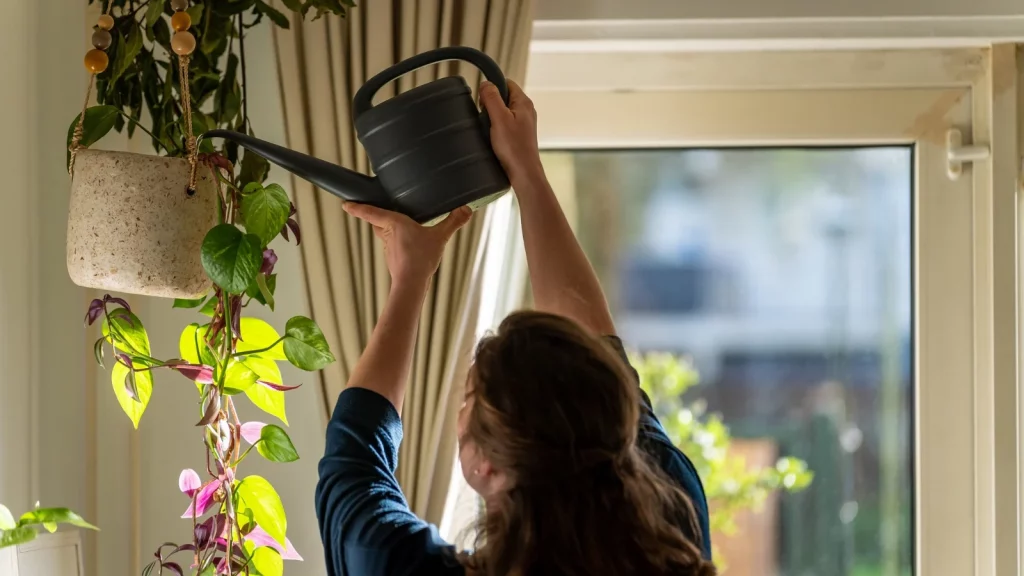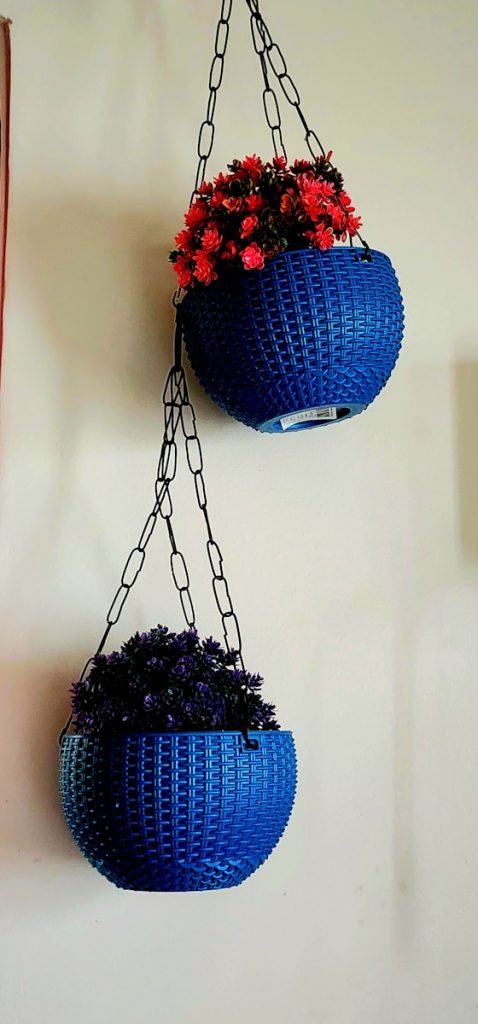Indoor hanging gardens are one of the easiest ways to add greenery when you’ve run out of floor or shelf space. With the right plants, hardware and a simple care routine, you can turn blank corners and bare windows into a leafy, floating jungle.
If you’d like more inspiration for vertical plant setups overall, pair this guide with your Indoor Vertical Plant Wall article, which shows another smart way to grow upwards instead of outwards.
Contents
- 0.1 What Is an Indoor Hanging Garden?
- 0.2 Best Plants for an Indoor Hanging Garden
- 0.3 Containers, Hooks and Hardware for Hanging Plants
- 0.4 Light, Watering and Drainage in an Indoor Hanging Garden
- 0.5 Styling Ideas for a Beautiful Indoor Hanging Garden
- 0.6 FAQs About Indoor Hanging Gardens
- 0.7 Final Thoughts on Indoor Hanging Gardens
- 0.8 Related Articles
- 1 Essential Tools for Small-Space Indoor Gardening
What Is an Indoor Hanging Garden?
An indoor hanging garden is simply a collection of plants suspended from the ceiling, walls, or window frames instead of standing on the floor. It’s perfect for small flats, rented spaces, and anyone who wants more greenery without cluttering surfaces.
A good indoor hanging garden:
Uses lightweight containers with proper drainage.
Groups plants that enjoy similar light and watering needs.
Takes advantage of vertical height near windows, corners and stairwells.
Stays safe and secure with the right hooks, brackets and fixings.
You can keep it as minimal as a single trailing pothos, or go full jungle with layered macramé hangers, shelves and wall hooks.
Best Plants for an Indoor Hanging Garden
Choosing the right plants makes indoor hanging garden care much easier. Look for species that trail, tumble or naturally arch outwards so they show off from above.
Great options include:
Pothos (Epipremnum aureum) – Fast-growing, forgiving and happy in bright, indirect light.
Spider plant (Chlorophytum comosum) – Tough, low-maintenance and produces baby plants that dangle nicely from the mother plant.
Heartleaf philodendron (Philodendron hederaceum) – Soft, cascading vines that thrive in many typical indoor conditions.
String of hearts / string of pearls – Beautiful for bright spots with good light and careful watering.
Boston fern (Nephrolepis exaltata) – Ideal if you can give it a slightly more humid spot away from harsh sun.
For low-light corners, consider snake plant, ZZ plant or other easy species in wall-mounted pots rather than full hangers.

Containers, Hooks and Hardware for Hanging Plants
Safe, secure fixings are essential for any indoor hanging garden. You want your plants to hang beautifully, not worry about them crashing down.
Containers
Lightweight plastic or resin pots are safer than heavy ceramic overhead.
Always choose containers with drainage holes so excess water can escape.
Use saucers or cachepots if you’re hanging over delicate surfaces.
A set of macramé plant hangers with simple plastic pots is an easy way to get started and works well with most trailing plants.
Hooks and brackets
For ceiling hanging, use strong metal ceiling hooks secured into a joist or with the correct fixings for your ceiling type.
Wall-mounted brackets are ideal for hanging baskets near windows or in corners.
Adhesive hooks are usually only suitable for very small, lightweight plants.
If you’re unsure what your walls or ceilings are made from, it’s worth checking guidance on safe fixings for your specific property type before drilling.
Light, Watering and Drainage in an Indoor Hanging Garden
Every indoor hanging garden needs the basics: the right light, consistent watering and good drainage.
Light
Most hanging plants prefer bright, indirect light.
Hanging near a window (but not pressed against hot glass) usually works well.
Rotate pots every few weeks so growth stays even and not one-sided.
According to RHS advice on houseplants, most indoor species are happiest in bright, filtered light rather than direct, scorching sun, especially behind glass in summer.
Watering and drainage
Watering hanging plants can be fiddly, but a simple routine helps:
Check moisture with your finger or a moisture meter before watering.
Take plants down to the sink or shower if possible, water thoroughly, then let them drain fully before rehanging.
Avoid leaving water trapped in decorative outer pots where roots can sit in soggy compost.
A small digital moisture meter can be handy if your indoor hanging garden has lots of pots at different heights and you don’t want to guess.

Styling Ideas for a Beautiful Indoor Hanging Garden
Once you’ve got the basics of plant choice and care, you can have fun styling your indoor hanging garden.
Consider:
Layered heights – Hang some plants close to the ceiling, others at eye level, and a few lower down to frame windows or corners.
Matching materials – Repeating macramé, black metal or natural wood helps everything feel intentional, not cluttered.
Trailing lengths – Mix short trailers with long, dramatic vines that almost reach the floor.
Room zones – Use hanging plants to separate a workspace from a living area in a studio flat.
Colour and texture – Combine glossy leaves, variegated patterns and finer foliage like ferns for contrast.
If you’re worried about pets or young children, hanging plants high up is also a clever way to keep more delicate or mildly toxic houseplants out of reach.

FAQs About Indoor Hanging Gardens
1. Do hanging plants need special soil?
Not usually. Most indoor hanging plants do well in a general houseplant potting mix that drains freely. You can add a little perlite if your compost feels heavy or stays soggy for too long.
2. How often should I water an indoor hanging garden?
There’s no fixed schedule. Check each pot individually and water when the top couple of centimetres feel dry. Plants closer to windows or radiators may dry out faster than those in cooler spots.
3. Can I grow herbs or edible plants in a hanging garden?
Yes, as long as they get enough light. Trailing herbs like thyme or oregano can look great in wall-mounted pots near a bright kitchen window.
4. Are indoor hanging gardens safe for renters?
Yes, as long as you use appropriate fixings and check your tenancy agreement. Removable tension rods or wall-mounted rails with hooks can be a good option if you want to limit drilling.
5. Which room is best for an indoor hanging garden?
Any bright room works: living rooms, kitchens, hallways and bathrooms with good ventilation. Just match plants to the light and humidity of the space.
Final Thoughts on Indoor Hanging Gardens
An indoor hanging garden is one of the most flexible ways to add greenery to your home. By using the vertical space that’s usually wasted – corners, ceilings, window frames – you can enjoy more plants without cluttering your floors or worktops.
Start small with one or two easy trailing plants in simple hangers. Once you see how they respond to your light and watering routine, you can gradually expand into layered displays, different container styles and more adventurous species. With a bit of planning and the right fixings, your indoor hanging garden will become a standout feature that makes every room feel fresher and more alive.
Related Articles
MAKE THE MOST OF EVERY INCH
Essential Tools for Small-Space Indoor Gardening
Once your hanging plants are up, the right tools make everyday care much easier. Our Small Space Gardening Tools guide shows you compact watering cans, precision pruners, and other space-saving essentials that keep your indoor garden tidy and low-stress – even in a tiny flat.

